After a slightly complicated trainsurfingtrip i arrived in Eindhoven, a small beautiful city in the south of Netherlands… if you go to Eindhoven Beukenlaan by train , you’ll see an old Philips Factory… and inside you find STRP, the Festival for Art, Technology and Music. already surprised at the entrance because of the metal-gates guiding the people in lines i was even more puzzled when entering the first zaal, called the brainport zaal… loads of people and sounds and action everywhere… was like entering at a luna park… ok, aaahhh, to much for the beginning… so, what to see first ? i took the festival program and looked for special lectures or performances which i might miss. oh, it’s dutch… do you have a english version ? …no, but look at the overview, it’s international ;-) ok, it wasn’t supposed to be an international festival… at least on the web-page you find all the info in english. even the lectures are in dutch. alright, i know german, so i could get some info’s out of “paradise bij the laptoplight”, a lecture with the topic “next nature“. how nature becomes culture and culture becomes nature. with international speed lectures (english ;-) , so i could understand better). quite informational and critic view about how we try to copy the nature, commercialise it and how all this is becoming nature again. on a broadsheet we got, you could read : “our technological world has become so intricate and uncontrollable that it has become a nature of its own” or “second life is not sustainable”.
after that i started to check out the exhibition… wandering around and had lots of fun… in the beginning i was sceptic about the dimension of the festival and the luna park approach, but actually i liked a lot how the people used the interactive works. it was no such shy distance like in other art exhibitions, where people just look, or maybe very carefully touch. the people really use it and even start to invent new ways of playing around. so it’s a hardcore-test for all interactive works here… after a very interesting and intensive exhibition and my exhausting travelling i was to tired to see the music-program, which was a pity, because there was a very good international lineup ! … so i missed modeselektor :-(
check out some works from the exhibition >>>
Archive for the ‘lectures’ Category
Page 4 of 5
I couldn’t attend to the presentation of this new tool, but i still want to spread the information it because – as far as i can say from the distance – it’s a very interesting low-cost development: The CUI is a interface board that lets you connect up to the 13 analog inputs (10-bit resolution) and buttons/switches to the digital inputs. It’s is kind of similar to the Arduino board with one big difference: It will be recognized by the system as a USB HIDevice, which means that you can get the data from the sensors into max/pd/suppercollider easily using the [hidio] object.
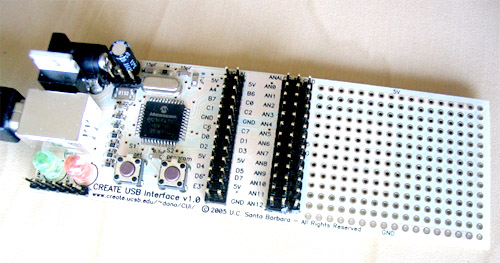
It’s based on a PIC processor, so you can of course also program it in both C and assemler – if you can. The Create USB Interface is available pre-built and bootloaded for $50 on the Create USB Interface homepage. There are also the schematics and part-lists available for download if you fancy soldering it on your own.
Yves Degoyon and Lluis Gomez and presented their recent pdp development PDVJ “pure data visual junk” – it’s all about image processing and visual work within pd that include helpful objects like a colorgrid to pick a color or a videogrid that shows all the videos of a folder.
also opencv (opencomputervision) will be included in pdp in something like a month. Its in full developement at the moment, they were finishing the pdp_opencv_blob object (a blob detection object) right before the talk, so this is cutting edge information. i can’t wait for this one.

also i’ll finally have to get a new computer because all the pdp stuff is done for linux – it also works on osx, but since you have to run X11 on aqua it will not be as fast as on linux. becaused it seems to be loads of work, it’s not planned to port it to window$ ;)
because of dependency problems it won’t be included to pd-extended, you’ll have to install it on your on.
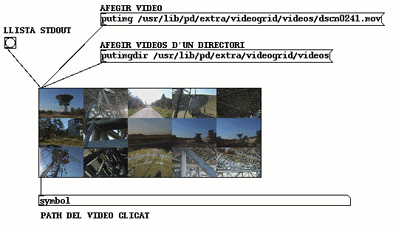

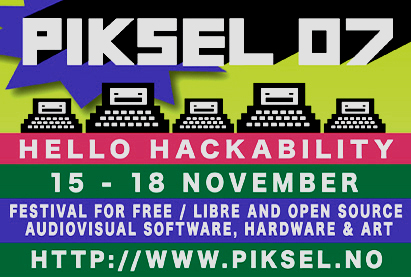
I arrived at the Piksel Festival and i’m about to gather all the documentation material – be sure to come back for more soon..
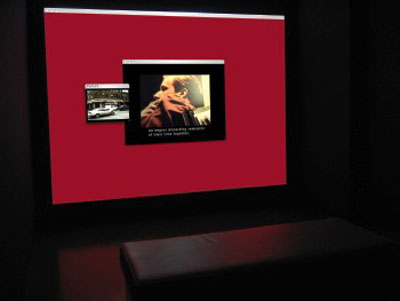
Today we talk with Peter Horvath, who has recently inaugurated a retrospective exhibition at the ACA Gallery of the Savannah College of Art and Design, in Atlanta.
Horvath presents a new DVD-installation, called Boulevard, together with other cinematic DVD’s and Internet-based video. He’s a pioneer of the genre, realizing a bridge between the nouvelle vague, the experimental cinema of the 70′s and the new possibilities of the browser-based cinema, the so-called webcinema.
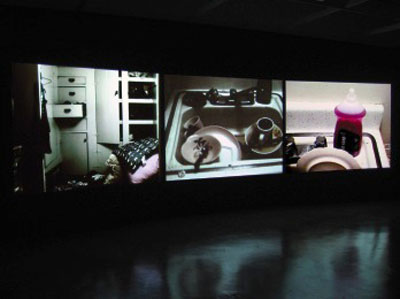
LUCA: In this solo exhibition, you will present your new piece “Boulevard”, what is it about?
HORVATH: Boulevard is a 3 channel video installation. It follows two enigmatic, nameless people through their nighttime rendezvous, their drives through California canyons, their secrets, their confessions. I wanted to create a kind of intimate theatre, accessible from the web browser, a dreamlike odyssey that examines multiple states of consciousness within a shadow of family histories.
Filmed in Los Angeles, mostly at night and in the Laurel Canyon/Hollywood Blvd area close to Mullholland Drive, it’s the first work I’ve done that is made for both the web and an installation situation, constructed so that once finished for the web it could be re-constructed into 3 separate DVD’s that are projected simultaneously.
LUCA: What are the influences of the web to cinema, and how has cinema mutated migrating on a network?
HORVATH: I’ve always been interested in fragmenting my narratives, and I’ve done so in past work by having multiple windows open and close within the web-browser environment, playing out various parts of the story. Boulevard is slightly different from past work in that there are no pop-up windows, and instead I’ve divided the screenspace into 3 panels of video. In the web version there are randomly placed texts that appear below the videos that tell a different part of the narrative, fragmenting things further.
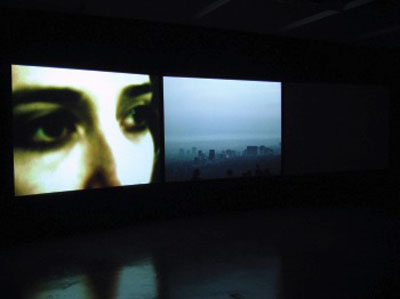
LUCA: I think webcinema, particularly, is an individual experience, like cinema; how did you manage to install your webcinema pieces in an open space?
HORVATH: I try to create intimate spaces to project the works large scale, but of course the intimacy is different compared to the one on one we have when interacting with the computer. With the ACA show, we constructed 4 rooms, 1 for each work.
LUCA: Talking about cinema, who are your favourite contemporary authors?
HORVATH: Krzysztof Kieslowski, Scorsese, Truffault (can he be considered contemporary?) but my influences lean more toward artists than filmmakers; Bill Viola, Barbara Kruger, Jenny Holzer, Francis Bacon and the Dadaist Hannah Hoch to name a few.
The Seminar interrupting realities was about artistic approaches to mixed reality. About possibilities, visions and the borders between virtual and real, 2nd life and 1st life.
A very interesting project in the virtual world of art is common grounds from workspace unlimited (founded by Thomas Soetens and Kora Van den Bulcke) Startet in Belgium it has 3 terminals (Ghent, Montreal and Rotterdam) This Terminals are in the physical environment of the virtual space you can explore. So you walk virtualy through the building you are in – you are doublepresent, physical and virtual. Your virtual representation is not only your avatar walking around, it´s also your image is transported into the world of workspace unlimited. In different rooms you have different possibilities of interaction. e.g. in a conferenceroom, you can comunicate with other users – their webcamimages are projected virtualy on the walls of the conferenceroom.
EI 4 (Exercise in Immersion 4) from Marnix de Nijs also connects physical with simulated world, a game starting on the border to reality. Wearing a special designed crashsuit with camera and HMD you start in the electronic reproduction of your surrounding physical world. But starting to move around – an unknown virtual environment is taking over. You should be familiar with his work Run Motherfucker Run.
Another very interesting speaker was Armando Menicacci (F), director of Laboratoire Médiadanse, Anomos He talked about the complexity of movement and gestures of a body, problems of tracking and analysing the data… It´s like dancing and sports, while sports has objective measureable datas, dance is based on subjective expression. Out of a tracked movement you will not get an expression or meaning of the movement, just datas like direction, position & duration. to get an idea of what he was talking about you can check the video of the tracking workshop, which he hold together with Christian Delecluse, Cyrille Henry (pmpd-library), Sher Doruff (Waag Society, Amsterdam), Stan Wijnans Cliff Randell from the University of Bristol, UK
After a livechat in 2nd life the seminar closed with a realtimeperformance in 2nd life from David “DC” Spensley (US), a.k.a. DanCoyote Antonelli (Second Life), cultural producer and artist.
2nd life – either u like it or not. more boring than 1st life ? or is it getting your real life allready ? as a somehow copy of existing physical world it´s not a 2nd life i am interested in. why does it need gravity ? even the architecture looks like in our known physical world, and the avatars have human bodies. i better stay in 1st life ! where i don´t need a mouse to move around ! and just integrate my virtual presence in 1st life, but not in realtime !
but have a look at the performance from David “DC” Spensley – skydancer. at least he disconnects gravity
Marguerite Charmante in collusion with Fleshgordo created the Ludic Society in Bilbao Spain in 2005 as an international association of game practitioners and thinkers who seek to provoke the new artistic research discipline of ludics or indulgent play. Usually for members only, on this night anyone could gamble for membership.
realplay ! the evening started with a play taking 5 people out of the audience with the mission to bring and rfid-tagged flower to their instructed destination. with googleearth overlay you could follow the game. rfid-tags. in your body – in your city. tag your environment, tag your life, tag or die !! play life ! go ape ! the ludics have very good ideas about plays. they extend the field and connect virtual with physical world, move your bones – not the mouse. they sell play ! no games !
late review of DEAF07. because i participated the trackingworkshop i didnt have much time to write during the festival, and also it was packed with not-to-be-missed program, so it was a real good and interesting festival i can recommend !
interact or die !!!
i dont see the interaction as a destiny like luca, but more like a dying hype in mediaart. last years interaction was a main theme and i understand the title it is more like a persiflage on interaction.
Generally speaking – everything is interaction. Every perception is already an action, so perceiving an “non-interactive work” is already interacting.
In the Symposium on Saturday Interaction was a maintheme, seen from different perspectives like artistic, architectonic, social, political, biological and cognitive. The speakers were Detlef Mertins, Lars Spuybroek, Howard Caygill, Noortje Marres and Jeanne van Heeswijk
A pity i missed, but it should be online as realvideostream
also the other seminars you should be able to watch
There is also a very good blog with loads of pix and interviews with some artists on the DEAF website
10 laws:
REDUCE ORGANIZE TIME LEARN DIFFERENCES
CONTEXT EMOTION TRUST FAILURE THEONE
John Maeda talked yesterday night at the Mediateca Santa Teresa in Milan, in a open conference organized by MGM digital communication for his series of meeting Meet the Media Guru.
As John Maeda started to talk he said that he considered himself a mediaguy rather than a mediaguru, and i felt myself immediately better. “The computer is nothing more than a pencil” said April Greinman 20 years ago, and Maeda said that if it’s a pencil, it’s one that broke his tip continously, again and again.
What is semplicity about? semplicity=simplistic? =trend? =more sales? =?
it’s a question with no answer….and we’re at the beginning. So he started to present to the audience how easy it’s possbile to see semplicity and beauty into everyday life, showing photos he did from the complexity of the Dome of Milan to the simplicity of a dead white butterfly on a black asphalt: “the world is a great museum to visit“, you’ve just to open your eyes.
“Capitalism utilize the machine not to further social welfare, but to increase private profit.” Lewis Mumford, Technics and Civilization, 1934
Design is about merging human sensibility and technological aspects, and the human desires are mutable, sometime you want more, sometime less, usually if it’s about pleasure you want more, if about work less.
He started then to present more deeply the book he just edited for MIT Press, called The Laws of Simplicity. And he said since the beginning he wont show all the principles, he did the book for the pourpose and there everything is clearly explained, so read it!!!
Then a quick talk about four laws, about this part was particularly interesting the “SHE’s alwasy right” paradigm, that present a metodology that is always good for design: Shrink, Hide, Embody. Some clear example of this attitude are the evolution of the interface of the I-pod and the shell phone design. So at the fourth law, Learn, he stopped talking about the laws of simplicity and it started the best part of the conference with Maeda seriously telling to the audience how important is to look with a curious eye to the world and to spend time in relational activities: “Friends are forever, spend life making friends, not money”.
At the beginning of the conference he clearly said he thought about 10 laws, but they can be 3, 2 or more, he don’t knows what can happen, but that are his laws about complexity for now and at the end he said what i think are the real laws of Maeda’s way of life:
“To live is learn to forget”
“Everything is already there, so don’t think too much, but keep on doing”
“Look for things that gives you hope, life is great”
then the questions, sincerely not so interesting but among them turned out this:
Q: Artists that inspired you?
A: Duchamp, Bruno Munari and Italo Calvino.
Q: is it really important to learn programming to make design today?
A: Programming is quite boring. 5 years ago i would said yes, now… i don’t know.
Programming is sharp, but life is about emotion, so i hope in the future programming can be softer.
Q: How do you see ther future?
A: I don’t the future i see, i can say the future i want: a future as a friendly place.
and i started clapping my hands….
http://lawsofsimplicity.com


Socialize